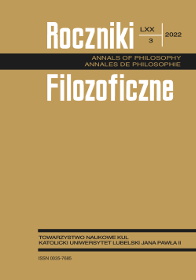Paradoks fikcji — krytyczny przegląd głównych teorii
Abstrakt
Przedmiotem artykułu jest paradoks fikcji. Prezentuję wybrane najważniejsze próby jego wyjaśnienia i rozwiązania. Twierdzę, że ów paradoks wynika z przyjęcia silnego założenia, że do powstania reakcji emocjonalnej niezbędne jest przekonanie o realnym istnieniu czegoś. Przekonanie to wcale nie jest jednak konieczne — można bać się, że p, a równocześnie nie mieć silnego przekonania, że p. Wystarczy posiadać określoną myśl. Bronię tezy, że nasze reakcje emocjonalne zapośredniczone są przez umysł i jego reprezentacyjno-treściowe wyposażenie. Ze względu na skromne piśmiennictwo poświęcone temu tematowi w języku polskim artykuł został napisany w języku rodzimym autora. Artykuł ma zatem charakter edukacyjny i przede wszystkim popularyzacyjny.
Bibliografia
Brann, Eva T.H. 1991. The World of the Imagination: Sum and Substance. Savage, MD: Rowman & Littlefield.
Buckareff, Andrei A. 2010. „Acceptance Does Not Entail Belief”. International Journal of Philosophical Studies 18: 255–261. DOI: https://doi.org/10.1080/09672551003677838.
Carroll, Noël. 1990. The Philosophy of Horror or Paradoxes of the Heart. New York: Routledge.
Carroll, Noël. 2004. Filozofia horroru. Tłum. Mirosław Przylipiak. Gdańsk: słowo/obraz terytoria.
Casey, Edward S. 1976. Imagining: A Phenomenological Study. Bloomington, IN: Indiana University Press.
Clarke, David S. 1994. „Does Acceptance Entail Belief?”. American Philosophical Quarterly 31: 145–155. DOI: https://doi.org/10.1080/09672551003677838.
Cocking, John M. 1991. Imagination: A Study in the History of Ideas. London: Routledge.
Cohen, Jonathan. 1992. An Essay on Belief and Acceptance. Oxford: Oxford University Press.
Coleridge, Samuel T. 1920. Biographia Literaria. W: Collected Works, t. 7, cz. 2. Cambridge: Cambridge University Press.
Currie, Gregory 1990. The Nature of Fiction. Cambridge: Cambridge University Press.
Currie, Gregory 1995. Image and Mind: Film, Philosophy and Cognitive Science. Cambridge: Cambridge University Press
Egan, Kieran, & Dan Nadaner, eds. 1988. Imagination and Education. Milton Keynes, U.K.: Open University Press.
Ekman, Paul. Emocje ujawnione. Odkryj, co ludzie chcą przed tobą zataić i dowiedz się czegoś więcej o sobie. Tłum. Wojciech Białas. Gliwice: Wydawnictwo HELION.
Engell, James. 1981. The Creative Imagination: Enlightenment to Romanticism. Cambridge, MA: Harvard University Press.
Hartz, Glenn. 1999. „How We Can Be Moved by Anna Karenina, Green Slime, and a Red Pony”. Philosophy 74: 557–578.
Joyce, Richard. 2000. „Rational Fear of Monsters”. British Journal of Aesthetics 40, no. 2: 209–224. DOI: https://doi.org/10.1093/bjaesthetics/40.2.209.
Kearney, Richard. 1988. The Wake of Imagination: Ideas of Creativity in Western Culture. London: Hutchinson.
Kind, Amy, i Peter Kung. 2016. Knowledge through Imagination. Oxford: Oxford University Press.
Konrad, Eva-Maria, Thomas Petraschka i Christiana Werner. 2018. „The Paradox of Fiction — A Brief Introduction into Recent Developments, Open Questions, and Current Areas of Research, including a Comprehensive Bibliography from 1975 to 2018”. Journal of Literary Theory, vol. 12, no. 2: 1–4 (tam dalsza literatura). DOI: https://doi.org/ 10.1515/jlt-2018-0011.
Lamarque, Peter. 1981. „How Can We Fear and Pity Fictions?” British Journal of Aesthetics 21, no. 4: 291–304. DOI: https://doi.org/10.1093/bjaesthetics/21.4.291.
Moran, Richard. 1994. „The Expression of Feeling in Imagination”. Philosophical Review 103, no. 1, 75–106. DOI: https://doi.org/10.2307/2185873.
Neill, Alex. 1991. „Fear, Fiction and Make-Believe”. Journal of Aesthetics and Art Criticism 49.1, 47–56. DOI: https://doi.org/10.2307/431648.
Novitz, David. 1987. Knowledge, Fiction and Imagination. Philadelphia: Temple University Press.
Paskow, Alan. 2004. The Paradoxes of Art : A phenomenological investigation. Cambridge: Cambridge University Press.
Radford, Colin. 1977. „Tears and Fiction”. Philosophy 52: 208–213. DOI: https://doi.org/ 10.1017/S0031819100023159.
Radford, Colin, i Michael Weston. 1975. „How Can We Be Moved by the Fate of Anna Karenina?” Proceedings of the Aristotelian Society, Supplemental Volume 49: 67–80. DOI: https://doi.org/10.1093/aristoteliansupp/49.1.67.
Säätelä, Simo. 1994. „Fiction, Make-Believe and Quasi Emotions”. British Journal of Aesthetics 34, 25–34. DOI: https://doi.org/10.1093/bjaesthetics/34.1.25.
Schaper, Eva. 1978. „Fiction and the Suspension of Disbelief”. British Journal of Aesthetics 18, 31–44.
Smith, Murray. 1995. „Film Spectatorship and the Institution of Fiction”. Journal of Aesthetics and Art Criticism 53.2, 113–27.
Schneider, Steven. [s.d.]. „The Paradox of Fiction”. The Internet Encyclopedia of Philosophy (IEP), http://www.iep.utm.edu/fict-par/. Dostęp: 03.04.2022.
Stecker, Robert. 2011. „Should We Still Care about the Paradox of Fiction?” The British Journal of Aesthetics 51: 295–308. DOI: https://doi.org/10.1093/aesthj/ayr019.
Tan, Ed S. 1996. Emotion and the Structure of Narrative Film. New York: Routledge.
Tuomela, Raimo. 2000. „Belief versus Acceptance”. Philosophical Explorations, 2: 122–137.
Turvey, Michael. 1997. „Seeing Theory: On Perception and Emotional Response in Current Film Theory”. W: Film Theory and Philosophy, red. Richard Allen & Murray Smith, 431–457. Oxford: Oxford University Press.
Walton, Kendall L. 1978. „Fearing Fictions”. Journal of Philosophy 75, no. 1: 5–27. DOI: https://doi.org/10.2307/2025831
Warnock, Mary. 1976. Imagination. London: Faber & Faber.
Watson, Gerard. 1988. Phantasia in Classical Thought. Galway: Galway University Press.
White, Alan R. 1990. The Language of Imagination. Oxford: Oxford University Press.
Yanal, Robert J. 1999. Paradoxes of Emotion and Fiction. University Park, PA: Pennsylvania State University Press.
Copyright (c) 2022 Roczniki Filozoficzne

Utwór dostępny jest na licencji Creative Commons Uznanie autorstwa – Użycie niekomercyjne – Bez utworów zależnych 4.0 Międzynarodowe.





